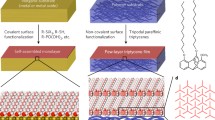Abstract
Charge injection into an organic semiconductor can be improved by using a self-assembled monolayer of functionalized molecules grafted on the electrode. This new interface can be designed in order to reduce the Schottky barrier between the conductive electrode and the organic semiconductor. The polarizability of the molecules involved can also be chosen in order to increase the adhesion of the molecular semiconductor onto the electrode. We present Kelvin Probe experiments and saturated photovoltage measurements performed on a number of such derivatized electrodes. They permit a quantitative description of the potential shifts due to the self-assembled monolayers which are related to the electrical dipoles of the individual molecules constituting them. When conjugated sites contributing to the band states of the organic semiconductor are placed too close to the electrode in the negative part of the image-force potential, two new effects unfavorable to charge injection can appear. We demonstrate that it is convenient to separate the attachment group of the molecule from the conjugated core by a spacer of non-conjugated sites in order to reduce these undesirable effects.
Similar content being viewed by others
Author information
Authors and Affiliations
Rights and permissions
About this article
Cite this article
Zuppiroli, L., Si-Ahmed, L., Kamaras, K. et al. Self-assembled monolayers as interfaces for organic opto-electronic devices. Eur. Phys. J. B 11, 505–512 (1999). https://doi.org/10.1007/s100510050962
Received:
Revised:
Published:
Issue Date:
DOI: https://doi.org/10.1007/s100510050962



